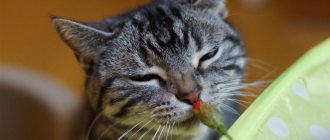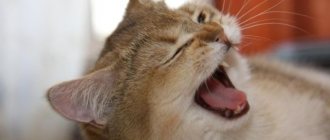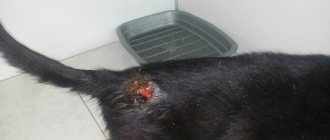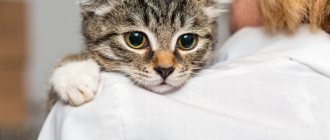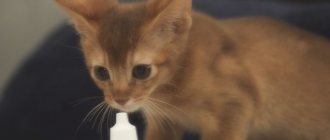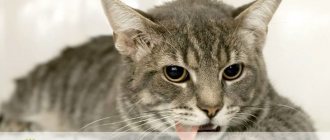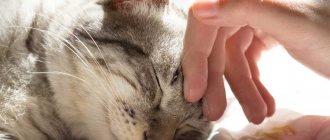The causes of sneezing in a cat can be caused by the entry into the nasal passages of various irritating particles and substances, foreign bodies, as well as bacteria, viruses and allergens that cause various diseases.
Sneezing itself is one of the unconditioned reflexes aimed at protecting the body, necessary for quickly eliminating pathological irritants from the nasal passages.
Domestic cats are capable of sneezing just like humans. A one-time sneeze should not cause concern to the owner, but a systematically repeated reflex can cause the development of serious pathological processes.
It is important to understand when sneezing is normal and when to seek help from your veterinarian for help and advice.
When is it normal for a cat to sneeze?
The reflex act of sharply inhaling deeply and exhaling forcefully through the nasal passages is called sneezing. During the process of the unconditioned reflex, various muscle groups are involved in order to carry out the strongest possible release of air from the deep parts of the lungs to cleanse the mucous membranes of unnecessary particles and irritating components. Unlike dogs, a cat can sneeze multiple times at once.
In order to clear its nasal passages, the cat actively takes a deep breath. All particles that were in the nasal passages are expelled by sneezing. Sneezing is normal and is characterized by several sets of 2-3 active sneezes. If accompanying symptoms occur, such as a runny nose, active discharge of mucous exudate from the nasal passages, lacrimation and swelling of the nose, you should consider visiting a veterinarian.
It is not too difficult to distinguish a normal condition from a pathological one. An attentive owner always notices changes in the pet’s condition in a timely manner.
A cat that sneezes from time to time and does not have parallel symptoms is absolutely healthy. The cause of sneezing can be not only dust, but also various aerosols, for example, air freshener.
The signs that appear in parallel when sneezing should alert the cat owner. Acute diseases are characterized by a specific reflex of clearing the nasal passages, loss of appetite or complete refusal to feed, lethargy and apathy. And pathological processes are accompanied by a runny nose and sudden discharge of mucous exudate.
An animal may actively sneeze when the mucous membranes are irritated by aerosols, tobacco smoke, or perfumes. At the same time, the cat does not change at all in its behavior, it is active, healthy, and does not lose its appetite. The sneezing is short, single.
What does the cat’s “Apchhi!” mean?
First, let's agree that if a cat sneezes, say, 1-2 times a day, then there is no point in talking about any problem. The pussy may, for example, sneeze after inhaling dust particles or sand particles. But if the animal sneezes frequently, looks sick, and refuses to eat, then you should be wary and also make an appointment with a veterinarian as soon as possible.
To understand the problem, consider the reasons why a cat sneezes:
- Allergy
– a cat often sneezes when the nasal mucosa is irritated as a result of an allergy. A pet can be sensitive to a variety of substances: air fresheners, dust, pollen, smoke, fragrance oils, and so on. With allergies, cats not only sneeze, they may experience discharge from the eyes, skin rashes, vomiting, and shortness of breath; - Infectious diseases
of a viral, fungal or bacterial nature - with rhinotracheitis, bordetellosis, chlamydia, aspergillosis, cryptococcosis and other diseases, the cat may experience frequent sneezing (in some cases with blood). The symptoms of all these diseases vary, but there is something in common: the cat has a fever, coughs, refuses to eat, mucus or pus comes out of her nose, her eyes are often inflamed, there may be stool disorders; - Foreign bodies stuck in the nasal cavity
- almost all cats are naturally curious, so small pebbles, twigs, and beads often get into their small nasal passages. Sometimes insects become foreign bodies. Any foreign object that gets into a cat's nose can cause uncontrollable sneezing, discharge from the nostrils (usually mucous, but if the nose is damaged, blood may also be present), anxiety, heavy and noisy breathing; - Nasal polyps
– if there are neoplasms on the mucous membrane of a cat’s nose, then in such cases the animal constantly sneezes, rubs its nose with its paw, sniffles, and clear snot flows from its nose; - Asthma
- a cat sneezes and coughs and has problems with the bronchi. The mucous membranes of an animal with asthma turn pale, breathing becomes hoarse, the pet swallows air with an open mouth, looks weak and apathetic; - Oncology of the nasal cavity
- fortunately, nasal cancer is rare in cats, and usually such a serious illness occurs in older animals. More often than others, this type of oncology is observed in European shorthaired cats. With cancer, a pet sneezes blood, loses its sense of smell, bumps may appear on its face, and tears flow from its eyes. If the disease is advanced, the unfortunate purr loses a lot of weight, does not eat, and suffers from cramps. Unfortunately, non-treatment (or untimely assistance) is fraught with the death of the animal, while proper therapy gives a chance to save the long-eared pet friend; - Worms
- if your cat is coughing, sneezing and has watery eyes, then the problem may be nasty worms that have infected the respiratory system. With worms, animals lose weight, lose their external luster, experience nausea and intestinal problems.
Pathological causes of cat sneezing
Among the factors that provoke sneezing in a cat are a number of pathological ones. Before starting therapy, the doctor always conducts diagnostic tests to find out the cause of sneezing.
The main pathological causes of sneezing in cats are:
- Allergic type reactions. When the mucous membranes are irritated by allergens, frequent sneezing occurs. The cause of such an allergic condition can be various household chemicals, particles of which float in the air, detergents, oils and scented candles, and air fresheners.
- Colds. The cause of a cold is most often hypothermia of the body and a decrease in immune strength. In addition to sneezing, the cat has a runny nose and an increase in body temperature.
- Infectious lesions. Various fungal, bacterial and viral infections often affect the animal's respiratory tract. There is also discharge from the eyes, increased body temperature, and a severe cough.
- Helminthiases. Some types of worms can affect the respiratory tract. Settling in the respiratory organs, helminthiases are characterized by rapid breathing, runny nose, attacks of nausea and vomiting. Against the background of long-term infection with worms, the animal loses weight, and exhaustion of the body may occur. All helminthiases, in the absence of timely treatment, lead to the development of serious changes in the body, the main of which is a decrease in the body’s immune forces.
How can you tell if your cat has a fever?
To assess how much your cat's temperature has risen, you need to measure it rectally. It is difficult for owners to assess the presence of fever objectively: a cat always seems hot to us, because normally it is warmer than a person. The condition of the nose, as we discussed in detail in the article “Why does a cat sneeze when the nose is hot and dry?”, is not a reliable indicator in this matter.
A slight increase in temperature - by 0.5-1 degrees - helps fight the disease, although it is accompanied by a deterioration in well-being. An increase of tenths of a degree (up to 39.1–39.2) can also be observed in a healthy animal, for example, under stress or after exercise.
Heat above 40°C already does more harm than good, and fever of 42 degrees and above can be deadly - at such high values, the proteins in our body begin to “collapse”, changing their structure like the protein in a boiled egg.
Dangerous reasons why a cat may sneeze
Pathological processes occurring in the body and characterized by sneezing can be extremely dangerous for the body. It is necessary to urgently seek help from a veterinary hospital if signs such as:
- sneezing accompanied by bloody discharge;
- nasal discharge when sneezing, characterized by the appearance of thick snot or pus;
- open-mouth breathing accompanied by sneezing;
- the presence of symptoms other than severe sneezing and nasal discharge.
The reason that the animal sneezes frequently and heavily, as well as other symptoms, may be:
- Foreign objects in the nasal passages or even in the esophagus . Most pets are extremely curious and can actively explore the world around them. Eating or inhaling small particles can cause blockage. Therefore, the reflex of clearing the nasal passages will be accompanied by heavy breathing.
- Formation of polyps in the nasal passages . The presence of benign growths or cystic neoplasms leads to constant irritation of the mucous membranes when inhaling air, so the cat may suffer from chronic runny nose and periodic sneezing.
- Development of bronchial asthma. Pets can suffer from a dangerous chronic disease, just like people. During an attack, the animal becomes lethargic, begins to sneeze, wheezing is heard and the visible mucous membranes become pale.
- Malignant tumors in the respiratory tract. Cancer of the nasal passages is rarely diagnosed in domestic cats, but it does occur. As a rule, cats with short hair and those who have reached 10 years of age are susceptible to the pathological process. Dangerous signs of nasal cancer in a cat are increased lacrimation, decreased appetite, loss of smell, and sneezing with droplets of blood.
Other possible causes of a runny nose
1. Caries. An infection in the oral cavity penetrates the nasopharynx, causing inflammation of the mucous membrane. As a result, the cat sneezes, its nose runs, and its eyes water. In this case, you need to contact a veterinarian to eliminate the cause of the runny nose.
2. Worms. Helminths are insidious creatures that can also cause runny noses in cats. Regularly - once every 3 months - give your pet anthelmintic drugs. This must be done because The cat is constantly licking something - the floor, the walls, street shoes, etc.
3. Allergies. Observe the animal's reaction to the aroma of your cosmetics/deodorants - perhaps they irritate the mucous membrane of his nose. Try to regularly clean the house of dust - it also serves as a powerful allergen for cats.
First aid for a sneezing cat
In the vast majority of cases, the cause of a sneeze in a cat is a common runny nose after hypothermia, due to a cold. At home, you can alleviate your pet's condition by rinsing the nasal passages. This procedure will help cleanse the mucous passages from possible allergens. In order to cleanse the nasal passages, it is recommended:
- Take the rinsing solution and warm it to room temperature. A saline solution sold in pharmacies for newborn babies is suitable.
- Draw the solution into a syringe with the needle previously removed, and using a towel to secure the cat on its side in a lying position, pour a little liquid into one, then into the other nostril.
- It is very important to take a short break before pouring the next portion of the solution. This is necessary so that the animal has time to get rid of the remains.
- At the end of the procedure of washing the nasal passages, you can blot your nose with a dry soft napkin and release the animal.
You can independently rinse your cat’s nasal passages with saline solution at home only if you have previously consulted with a veterinarian. The fact is that sneezing can be caused by a foreign body, and rinsing leads to the pushing of foreign particles into the deep parts of the respiratory system.
The best solution would be to take the animal to a veterinary hospital. The specialist will conduct a detailed examination and prescribe a series of studies to identify the main reason that provoked the development of a specific reflex for clearing the nasal passages.
Providing emergency care for a pet
Every cat owner should know the list of warning signs that indicate serious problems with the animal’s health:
- Weak and lethargic appearance.
- Uncontrollable vomiting.
- Dry hacking cough or blood in the sputum.
- Anxious and fearful behavior.
Veterinarians will provide the best care to a sick cat. By trying to cope with the problem on their own, the owners of the furry patient only complicate further treatment. Heart, lung, kidney and brain diseases cannot be treated with traditional methods at home.
In an emergency situation, when the veterinary clinic is far away and you need to act quickly, you can follow the following recommendations:
- A foreign object stuck in the throat can be pulled out with tweezers or your fingers. To do this, the cat opens its mouth wide and looks into its throat. If the object is within sight, you can act.
- An object lodged across the trachea can be shaken out of the animal by grasping the cat by the hind legs and pressing on the diaphragm. If the actions are not successful, you need to urgently take the sufferer to the veterinarian.
- If the owner is sure that poisoning has occurred, before the doctor arrives, the cat should be given a weak solution of potassium permanganate to drink. Gastric lavage is the first aid for poisoning of both animals and people.
Activities in the veterinary clinic
Sneezing is not a disease. This is a specific signal from the body indicating the presence of possible irritants in the nasal passages. It is imperative to visit a veterinarian, since there may be several reasons for the development of the protective unconditioned reflex. At the clinic appointment, the doctor will conduct a general clinical examination and auscultation. It is also important to:
- general blood test - to identify a possible inflammatory process;
- blood sampling for bacterial culture - allows you to identify the bacterial infection that provoked the pathology;
- rhinoscopy – necessary to determine blockage of the nasal passages by a foreign body;
- X-rays - to identify growths, cystic growths and other changes in the nasal passages.
When sneezing is caused by mechanical damage or exposure to chemical irritants, the main goal is to eliminate the irritant itself. If an animal begins to sneeze when exposed to household chemicals, it is important to eliminate the irritating factor and conduct a thorough wet cleaning of the room where the animal lives. Some indoor plants can be a possible allergen. It is necessary to remove all plants for a while. The veterinarian prescribes medications that relieve inflammation and block the production of histamine.
If a viral infection is suspected, the doctor conducts rapid testing to determine antigens. For this purpose, PCR and ELISA tests are prescribed. A specialist who often encounters infections in domestic cats may prescribe treatment even before receiving accurate test results.
If you suspect a fungal infection or the development of pathogenic bacterial microflora, it is advisable to carry out special bacterial cultures and take smears for cytology. Only after this is it possible to develop an accurate therapeutic regimen. Most viral respiratory infections occur with complications due to the addition of bacterial microflora. In this regard, the course of treatment is based on taking antibiotics.
Lack of timely treatment leads to serious pathological processes, including infection in the lower parts of the respiratory system. The cat may develop pneumonia, bronchitis, a disorder of smell, and even loss of the ability to see normally (for example, with the development of a herpes virus infection).
Depending on the factors that provoke the development of sneezing in a cat, medications and a course of therapy are prescribed. So, with:
- allergic reactions, the cause and antihistamines are identified (if necessary, dietary nutrition is prescribed);
- viral infections - anti-inflammatory drugs, as well as antibiotics in the presence of a complicated infection;
- bacterial diseases - a course of antimicrobial drugs and immunotherapy drugs and probiotics to restore the intestinal microflora;
- fungal infections - antifungal agents (the course of therapy is usually longer than in the presence of bacterial pathogenic microflora);
- foreign bodies in the respiratory tract - surgical intervention to remove the foreign object (endoscopic removal), as well as the introduction of anti-inflammatory drugs into the cavity;
- the presence of polyps - surgical intervention to remove the tumor;
- bronchial asthma - administration of antibiotics, glucocorticoids and prescription of inhalers (in case of severe illness, the animal must be urgently placed in a special chamber with oxygen during an attack;
- malignant neoplasms in the nasal passages - rhinotomy and the introduction of serious chemicals (chemotherapy);
- helminthiases localized in the pulmonary structures - antiparasitic agents, antihistamines and vitamin complexes.
The above methods are prescribed exclusively by a qualified veterinarian, based on the results obtained during diagnostic measures. At home, it is not possible to accurately determine the cause of the development of the pathological process and subsequent sneezing in a cat.
How to prevent cat sneezing
As we found out, sneezing is only a symptom of some illness. To prevent a cat from suffering from constant “Apchhi”, you need to:
- If your pet is sneezing due to an allergy, it is important to determine what is causing the pathological reaction. Once the allergen is identified, it will be necessary to eliminate or minimize its presence in the room where the pet lives;
- Infection cannot always be avoided, but it is better to exclude the cat from communicating with stray animals. For some ailments (such as rhinotracheitis), cats are given vaccinations, which help develop immunity to infectious agents;
- The apartment where an asthmatic cat lives must be crystal clean and regularly ventilated. Tobacco smoke should be avoided;
- Worms poison not only the respiratory system, but also the intestines, stomach, heart and other important organs. Cats are dewormed once a quarter (twice with a 14-day interval), even if there are no signs of worms at all;
- In order not to miss a serious disease at the initial stage, it is important to show your cat to a veterinarian at least once a year. And if you notice any alarming symptoms, you need to run to the clinic immediately.
Diagnosis of rhinotracheitis
Feline rhinotracheitis is diagnosed as follows: a swab is taken from the cat’s conjunctiva or nasal mucosa and submitted for PCR analysis (polymerase chain reaction), which determines the presence of viral DNA in the secretions.
Without laboratory diagnostics, it is impossible to make an accurate diagnosis; the clinical symptoms of rhinotracheitis are very similar to other respiratory infections. Rhinotracheitis and calicivirus have approximately the same level of prevalence among the domestic cat population; chlamydia is less common, but requires a different approach to treatment, so diagnosis is necessary.
